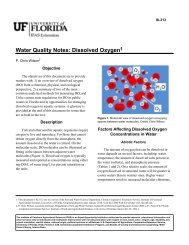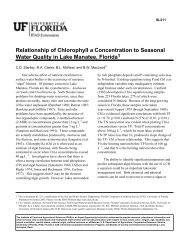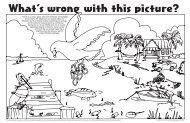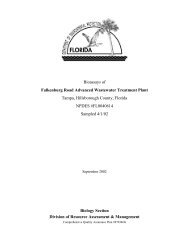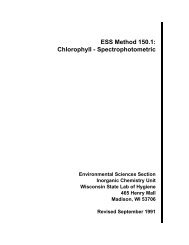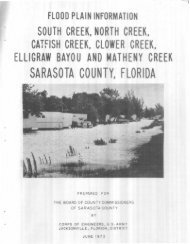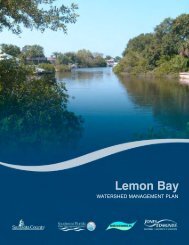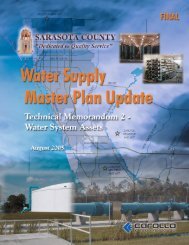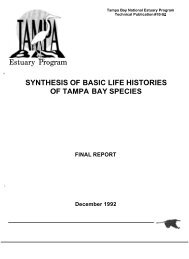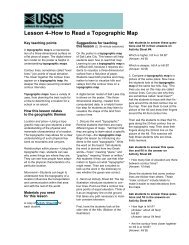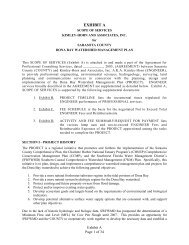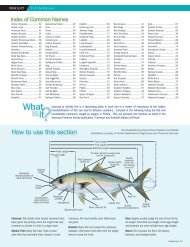Field Indicators of Hydric Soils in the United States - ITC
Field Indicators of Hydric Soils in the United States - ITC
Field Indicators of Hydric Soils in the United States - ITC
Create successful ePaper yourself
Turn your PDF publications into a flip-book with our unique Google optimized e-Paper software.
<strong>Field</strong> <strong>Indicators</strong> <strong>of</strong> <strong>Hydric</strong> <strong>Soils</strong>S9. Th<strong>in</strong> Dark Surface. For use <strong>in</strong> LRRs R, S, andT; for test<strong>in</strong>g <strong>in</strong> LRRs K and L. A layer 5 cm (2 <strong>in</strong>)or more thick entirely with<strong>in</strong> <strong>the</strong> upper 15 cm (6<strong>in</strong>) <strong>of</strong> <strong>the</strong> surface, with value 3 or less andchroma 1 or less. At least 70 percent <strong>of</strong> <strong>the</strong>visible soil particles <strong>in</strong> this layer must be covered,coated, or masked with organic material.This layer is underla<strong>in</strong> by a layer(s) with value 4or less and chroma 1 or less to a depth <strong>of</strong> 30 cm(12 <strong>in</strong>) or to <strong>the</strong> spodic horizon, whichever isless.Th<strong>in</strong> Dark Surface User Notes: This <strong>in</strong>dicatordescribes soils with a very dark gray or black nearsurfacelayer at least 5 cm (2 <strong>in</strong>) thick underla<strong>in</strong> by alayer where organic matter has been carried downwardby flow<strong>in</strong>g water (fig. 20). The mobilization andtranslocation <strong>of</strong> organic matter results <strong>in</strong> an unevendistribution <strong>of</strong> organic matter <strong>in</strong> <strong>the</strong> eluvial (E)Figure 20. Indicator S8 Polyvalue Below Surface (R) andIndicator S9 Th<strong>in</strong> Dark Surface (L). Organicmatter has been mobilized and translocated. Aspodic horizon is not required but commonlyoccurs <strong>in</strong> soils with <strong>the</strong>se <strong>in</strong>dicators. Scale is<strong>in</strong>ches.horizon. The chroma 1 or less is critical because itlimits application <strong>of</strong> this <strong>in</strong>dicator to only those soilsthat are depleted <strong>of</strong> iron. This <strong>in</strong>dicator commonlyoccurs <strong>in</strong> hydric Spodosols; however, a spodic horizonis not required.S10. Alaska Gleyed. For use <strong>in</strong> LRRs W, X, and Y.Dom<strong>in</strong>ant hue N, 10Y, 5GY, 10GY, 5G, 10G, 5BG,10BG, 5B, 10B, or 5PB, with value 4 or more <strong>in</strong><strong>the</strong> matrix, with<strong>in</strong> 30 cm (12 <strong>in</strong>) <strong>of</strong> <strong>the</strong> m<strong>in</strong>eralsurface, and underla<strong>in</strong> by hue 5Y or redder <strong>in</strong> <strong>the</strong>same type <strong>of</strong> parent material.Alaska Gleyed User Notes: Gley colors are notsynonymous with gray colors. Gley colors are thosecolors that are on <strong>the</strong> gley page (Gretag/Macbeth.2000). They have hue N, 10Y, 5GY, 10GY, 5G, 10G,5BG, 10BG, 5B, 10B, or 5PB, with value 4 or more.Color comparison to underly<strong>in</strong>g material must bebased on material <strong>of</strong> <strong>the</strong> same type or lithology.Loamy and clayey soilsLoamy and clayey soils refers to those soils withUSDA textures <strong>of</strong> loamy very f<strong>in</strong>e sand and f<strong>in</strong>er.Unless o<strong>the</strong>rwise <strong>in</strong>dicated, all m<strong>in</strong>eral layers aboveany <strong>of</strong> <strong>the</strong> <strong>Indicators</strong> have dom<strong>in</strong>ant chroma 2 orless, or <strong>the</strong> layer(s) with dom<strong>in</strong>ant chroma <strong>of</strong> morethan 2 is less than 15 cm (6 <strong>in</strong>) thick. Also, unlesso<strong>the</strong>rwise <strong>in</strong>dicated, nodules and concretions are notconsidered to be redox concentrations. Use <strong>the</strong>follow<strong>in</strong>g loamy and clayey <strong>Indicators</strong> for loamy orclayey m<strong>in</strong>eral soil materials:F1. Loamy Mucky M<strong>in</strong>eral. For use <strong>in</strong> all LRRsexcept N, R, S, V, W, X, and Y, those us<strong>in</strong>g A7, andMLRA 1 <strong>of</strong> LRR A. A mucky modified loamy orclayey m<strong>in</strong>eral layer 10 cm (4 <strong>in</strong>) or more thickstart<strong>in</strong>g with<strong>in</strong> 15 cm (6 <strong>in</strong>) <strong>of</strong> <strong>the</strong> soil surface.Loamy Mucky M<strong>in</strong>eral User Notes: Mucky is aUSDA texture modifier for m<strong>in</strong>eral soils. The organiccarbon is at least 8 percent, but can range to as highas 18 percent. The percentage requirement is dependentupon <strong>the</strong> clay content <strong>of</strong> <strong>the</strong> soil; <strong>the</strong> higher <strong>the</strong>clay content, <strong>the</strong> higher <strong>the</strong> organic carbon requirement.An example is mucky sandy loam that has atleast 8 percent organic carbon, but not more thanabout 14 percent organic carbon. See <strong>the</strong> glossary for<strong>the</strong> def<strong>in</strong>ition <strong>of</strong> mucky modified m<strong>in</strong>eral texture. Seefigure 37 (organic soil material) <strong>in</strong> <strong>the</strong> glossary fororganic carbon requirements.(430, FIHS, Ver. 5.01, March 2003) 13



